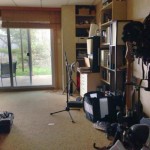Quick Review: Pro HDR
This is going to be quick. I plan to make Pro HDR a pick of the week on Systematic, so I’ll elaborate more then, but I thought it was worth a pointer for anyone who hasn’t seen it yet.
HDR is a set of methods for handling a broader range of exposures in a photographic image, usually achieved by taking multiple exposures and compositing the results. Apple’s iOS camera app has this capability built in, taking two exposures of an image and auto-detecting appropriate exposure levels. Pro HDR ($1.99) takes this a step further and provides manual controls and instant compositing in the app, along with brightness/contrast and saturation/tint settings. It also provides a set of Instagram-ish filters, if you so desire. The results are exponentially better than the default app.
While it has an auto mode, Pro HDR excels in the granular control provided by the manual mode. You get two squares that you can drag to the lightest and darkest points in the image, and when you move one it previews the exposure you’ll get for that spot. Then you just have to hold the camera still for long enough to take the two shots. On my iPhone 5 that’s about 3 seconds; long enough to shake and cause blur in the composite, but if you ground or mount the phone that’s easy to avoid.
The results are excellent, and within seconds I have a photo ready to share. I tested by turning the lights off in my office and pointing it at the window during sunrise. I was able to create an image that showed all of the trees outdoors while still picking up the details of the mess strewn around my workspace:
Later today I will be cleaning my office. Check out Pro HDR on the iTunes App Store (US $1.99).


